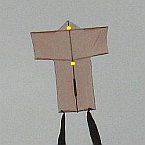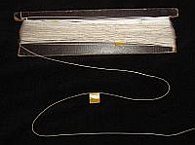- Home Page
- Kiting Knots
- Kite Parts
Kite Parts
A Glossary for Beginners
Here is a fairly comprehensive glossary of kite parts and other terms that are mentioned in the knot-tying instructions on this site. It's photo illustrated, of course, although I've kept the images quite small for quick loading on all devices.
Any term in italics may be looked up elsewhere in this alphabetically ordered set of descriptions.
On this site, there's more kite-making info than you can poke a stick at. :-)
Want to know the most convenient way of using it all?
The Big MBK E-book Bundle is a collection of downloads—printable PDF files which provide step-by-step instructions for many kites large and small.
That's every kite in every MBK series.
 2-point bridle
2-point bridle1-point, 2-point, 3-point
A 2-point bridle, for example, means that there are short lines coming from two separate points on the kite's frame, which then come together near the end of the flying line.
 Sand bag
Sand bagAnchor
An anchor is an object, such as a small sandbag, that is used to tie down a kite. Hence the owner can walk away and observe the kite flying without actually holding on. Very large kites are often anchored to heavy 4WD vehicles!
Bow
This is the curvature in a spar, like a drawn bow in archery. Most commonly, there is bow in a kite's horizontal spar that provides greater directional stability. With enough bow, kites need less tail, or even no tail at all, to fly stable.
Bow line
A bow line is a commonly used method of maintaining the bow in a spar. A line is tied from one end to the other. I like to use a toggle so a two-piece bow line can be undone, leaving the kite flat for transport.
 Bowed spar, showing bow-line and toggle
Bowed spar, showing bow-line and toggle Spring scales
Spring scalesBreaking Strain
This is the amount of tension it takes to snap a piece of line. The strain is commonly measured in kilograms or pounds. I like to take a set of spring scales with me to the flying field so I can check how hard my kite is pulling! A knot tied into a piece of line will decrease its breaking strain.
 Bridle
BridleBridle
This is a general term for all the short lines that are attached to the frame of the kite, some or all of which come together at one point where the flying line is attached. For my MBK designs, there is also a short connecting line coming from the bridle, to which is attached the flying line.
Bridle Leg
A section of line going from the kite's frame toward the flying line is called a leg; two such legs can often be part of one piece of line which has both ends attached to the kite. Hence this term is a little more precise than bridle line!
Bridle Line
One of the pieces of line in a kite's bridle. Confusingly, this can refer to either a bridle leg or a bridle loop! Bridle line is usually the same strength, or a little heavier, than the flying line of a kite.
Bridle Loop
A piece of line, both ends of which are attached to a kite's frame. A horizontal bridle loop with a sliding knot in the middle allows side-to-side tweaking to get a kite to fly straight. Similarly, a vertical bridle loop allows fore-and-aft adjustment to cope with low or high wind speed. Or an adjustment might be needed to get the kite to fly at all. :-)
 Cradle
CradleCamera Cradle
To take aerial photos with the camera suspended from the flying line, the camera is inserted into a lightweight cradle. Mine was constructed from bamboo skewers and paddle pop sticks. It did the job for many years. There it is in the photo.

Dowel
A long, cylindrical piece of hard material. My Dowel Series of kites use Tasmanian-oak hardwood dowel for all the spars and spreaders.
Flight Load
This is the bending, stretching, or compression force exerted on various parts of a kite due to the fact it is in flight. Spars bend away from the kite flier, sails eventually stretch like an old pair of jeans, and spreaders of delta kites are under compression during flight.
 Flying line
Flying lineFlying Line
This is the piece of line going from the ground to the bridle of the kite. See if you can spot the kite in the photo! Braided Dacron is the line material of choice for most single-line kite fanatics. More expensive materials are also used, which are stronger per unit of weight.
 Frame showing
Frame showingFrame
The frame of a kite is made from several sticks called spars. See the three sticks of the kite's frame showing through the pale-orange plastic sail in the photo. It is normal for some distortion of the frame to occur in flight. This becomes most apparent when the kite is close to its upper wind-speed limit.
 An end fray
An end frayFray
The cut end of a piece of line will fray over time as the fibers unravel. Some kite fliers, like myself, like to put a simple knot into the line right near the end to prevent any fray from progressing further. Others like to melt the end of the line with a flame, which is a somewhat neater approach. Fray can also refer to damage that occurs midway along a line due to abrasion. In that case, broken fibers can have a fluffy appearance and indicate that the breaking strain of the line is not what it used to be!
Horizontal Spar
This is the stick that holds out the "wings" of a typical sparred kite, extending from one side to the other as you look at the kite in flight. Some kites have more than one horizontal spar. Modern spars can be rods or tubes of artificial material.
 Keel
KeelKeel
Keels are less common nowadays and are most commonly seen on delta kites. A keel is most often a flat, triangular sheet that is attached between the end of the flying line and the vertical spar of a kite.
 Kite line
Kite lineKite Line
This refers to line of a type that is useful for many applications in kite flying. For example, the flying line, the bridle lines, ties, and other uses associated with attaching stabilizing devices to the tail end of a kite. The line in the photo is 50-pound braided Dacron.
Nose
That part of a kite which, when all is well, points directly into the wind when the kite is in flight! The nose is at the top, initially, when the kite is first launched.
 Prusik, locked
Prusik, lockedSliding Knot
A knot which can remain done up while being shifted back and forth along a piece of line. I prefer the Prusik, since this knot can be unlocked for sliding and locked again to hold the desired position. It's a complex knot, but it doesn't have to be undone! With plenty of unlocking and locking, the short end can eventually pull through, so I usually use a terminator with this knot—unlike in the photo, which is just illustrating a locked Prusik.
Spar
A stick, rod, or tube that forms part of the frame of a kite, to which the sail is attached. Bamboo is a favored traditional spar material, while modern spars can made from fiberglass or carbon fiber. GRP (Glass Reinforced Plastic) is a term often seen, which is the same as carbon fiber. I like to be different, with most of my largest MBK designs using hardwood dowel and carefully designed bridles to ensure the wood doesn't snap in flight!
 Spreader
SpreaderSpreader
This is the cross stick that keeps a delta kite (for example) spread relatively flat during flight. In the photo, you can see the ends of the spreader poking out to left and right.
 Suspension line
Suspension lineSuspension Line
A length of line that suspends an object from the flying line of a large kite. Such objects can be non-flying inflatables, a camera cradle, or a flag. See the suspension line near the top of the photo—passing through pulleys and holding a rather fancy KAP rig for aerial photography!
 Long tail
Long tailTail
A length of light material that is attached to the tail end of a kite and serves to keep the kite pointing into the wind. Sometimes many tails are used. Tails can also be useful hanging off the wingtips of a kite to help dampen its motion in the air. Tails are sometimes used purely for looks!
 Terminator
TerminatorTerminator
The knot that will be back. Just kidding—I use a terminating knot near the end of a piece of line to prevent another knot from pulling through when under strain and/or motion. In the photo, the small Loop knot terminator to the right will prevent the simple Slip knot from pulling through when tightened. A Prusik knot will never pull through immediately after being tied, but it might eventually, after a lot of use. Hence a terminating knot is handy. Here's another example—a Simple knot terminating the end of a line will prevent a long fray from developing.
 Tie
TieTie
A short piece of line that attaches one part of a kite to another. For example, a shoelace that is used to tie one spar to another at the crossing point or some light line that attaches corners of a sail to a solid part of the kite as in the Dowel Dopero or Roller designs.
 Toggle
ToggleToggle
With MBK kites, a short piece of dowel that is inserted through a loop to secure a two-piece bow line in the middle. The two lines are drawn together, bending a spar, before the toggle is inserted to hold some bow in the spar.
 Towing point
Towing pointTowing Point
Or tow point. Or more technically, the fulcrum of a kite. This is the point or points around which the kite is free to rotate in pitch. That is, in a nose-up or nose-down manner. For most single-line kites (but not sleds!), this point is where the flying line diverges into several bridle legs that attach to the kite. See the illustration. The position of the towing point relative to the kite makes a lot of difference to how the kite flies—or if it flies at all! Some kites have a single attachment point to the kite; in this case, that point is also the towing point.
 Train
TrainTrain
This is a number of kites all flying on the same flying line. A simple example is a train of diamond kites, where the flying line attaches to each kite at its towing point on the vertical spar. For the simplest of diamonds, this where the sticks cross.
Vertical Spar
The stick or tube that goes from the nose end to the tail end of a kite and is sometimes referred to as the "spine." Some designs, like the dopero and the original genki, have more than one vertical spar.
That's it for this glossary of kite parts. I hope it has proved to be of some use to you!
As mentioned earlier, there's more kite making on this site than you can poke a stick at. :-)
Want to know the most convenient way of using it all?
The Big MBK E-book Bundle is a collection of downloads—printable PDF files which provide step-by-step instructions for many kites large and small.
That's every kite in every MBK series.
